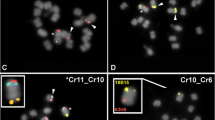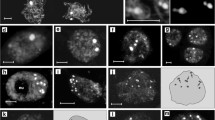Abstract
Root tips were pulse-labelled with tritiated thymidine. Late-labelled regions were mapped by quantitative autoradiography of metaphase chromosomes collected 11 h after the pulse for longiflorum (mean G2=14 h), and 13 h for pardalinum (mean G2=18 h). Late label in both species was preferentially located in sub-distal regions of the longer chromosome arms. Minimal labelling occurred in centromeric areas. — Some brightly Q-banded regions were late labelled, and some dull areas were not. However, late patterns were considerably more localised than bright Q-bands, and late regions were closely similar between species whereas Q-band patterns are not. Therefore bright Q-bands are apparently not consistently late replicating in Lilium, as they are in mammals, and they may therefore represent a different category of chromosomal substructure. — Centromeric C-bands and those at most nucleolar organisers were not late labelled. Only the more distal intercalary C-bands replicated late, and they were not significantly later than the chromatin surrounding them.
Similar content being viewed by others
References
Barlow, P.W., Vosa, C.G.: The pattern of DNA replication in the chromosomes of Puschkinia libanotica. Chromosoma (Berl.) 28, 457–467 (1969)
Baumann, T.W.: Heterochromatin und DNS-replikation bei Scilla sibirica Exp. Cell Res. 64, 323–330 (1971)
Belling, J.: The ultimate chromomeres of Lilium and Aloë with regard to the numbers of genes. Univ. Calif. Publ. Bot. 14, 307–318 (1928)
Bostock, C.J., Christie, S.: Chromosome banding and DNA replication studies on a cell line of Dipodomys merriami. Chromosoma (Berl.) 48, 73–87 (1974)
Bostock, C.J., Christie, S.: Chromosomes of a cell line of Dipodomys panamintinus (kangaroo rat) A banding and autoradiographic study. Chromosoma (Berl.) 51, 25–34 (1975)
Crossen, P.E., Pathak, S.E., Arrighi, F.E.: A high resolution study of the DNA replication patterns of chinese hamster chromosomes using sister chromatid differential staining technique. Chromosoma (Berl.) 52, 339–347 (1975)
Das, R.K., Savage, J.R.K.: Chromosome replication patterns in the djungarian hamster (Phodopus sungorus). Chromosoma (Berl.) 67, 165–176 (1978)
Döbel, P., Schubert, I., Rieger, R.: Distribution of heterochromatin in a reconstructed karyotype of Vicia faba as identified by banding- and DNA-late replication patterns. Chromosoma (Berl.) 69, 193–209 (1978)
Evans, G.M., Rees, H.: The pattern of DNA replication at mitosis in the chromosomes of Scilla campanulata. Exp. Cell Res. 44, 150–160 (1966)
Fussell, C.P.: The position of interphase chromosomes and late replicating DNA in centromere and telomere regions of Allium cepa L. Chromosoma (Berl.) 50, 201–210 (1975)
Ganner, E., Evans, H.J.: The relationship between patterns of DNA replication and of quinacrine fluorescence in the human chromosome complement. Chromosoma (Berl.) 35, 326–341 (1971)
Gill, B.S., Kimber, G.: The giemsa C-banded karyotype of rye. Proc. nat. Acad. Sci. (Wash.) 71, 1247–1249 (1974)
Greilhuber, J.: Why plant chromosomes do not show G-bands. Theor. Appl. Genet. 50, 121–124 (1977)
Greilhuber, J., Speta, F.: C-banded karyotypes in the Scilla hohenackeri group, S. persica and Puschkinia (Liliaceae). Plant Syst. Evol. 126, 149–188 (1976)
Holm, P.B.: The C and Q banding patterns of the chromosomes of Eilium longiflorum (Thunb.). Carlsberg Res. Commun. 41, 217–224 (1976)
Holm, P.B.: The premeiotic DNA replication of euchromatin and heterochromatin in Lilium longiflorum (Thunb.). Carlsberg Res. Commun. 42, 249–281 (1977a)
Holm. P.B.: Three-dimensional reconstruction of chromosome pairing during the zygotene stage of meiosis in Lilium longiflorum (Thunb.). Carlsberg Res. Commun. 42, 103–151 (1977b)
Hsu, T.C., Markvong, A.: Chromosomes and DNA of Mus: Terminal DNA synthetic sequences in three species. Chromosoma (Berl.) 51, 311–322 (1975)
Hungerford, D.A., Hungerford, A.M.: Chromosome structure and function in man VI. Pachytene chromomere maps of 16, 17 and 18; pachytene as a reference standard for metaphase banding. Cytogenet. Cell Genet. 21, 212–230 (1978)
Kongsuwan, K., Smyth, D.R.: Q-bands in Lilium and their relationship to C-banded heterochromatin. Chromosoma (Berl.) 60, 169–178 (1977)
Kongsuwan, K., Smyth, D.R.: DNA loss during C-banding of chromosomes of Lilium longiflorum. Chromosoma (Berl.) 68, 59–72 (1978)
Kuroiwa, T., Tanaka, N.: DNA replication pattern in somatic chromosomes of Crepis capillaris. Cytologia (Tokyo) 35, 271–279 (1970)
Latt, S.A.: Fluorescence analysis of late DNA replication in human metaphase chromosomes. Somatic Cell Genet. 1, 293–321 (1975)
Lima-de-Faria, A., Jaworska, H.: Late DNA synthesis in heterochromatin. Nature (Lond.) 217, 138–142 (1968)
Lima-de-Faria, A., Jaworska, H.: The relation between the chromosome size gradient and the sequence of DNA replication in rye. Hereditas (Lund) 70, 39–58 (1972)
Matagne, R.: Duration of mitotic cycle and patterns of DNA replication in chromosomes of Allium cepa. Caryologia (Firenze) 21, 209–224 (1968)
Miller, O.J.: Is the centromeric heterochromatin of Mus musculus late replicating? Chromosoma (Berl.) 55, 165–170 (1976)
Okada, T.A., Comings, D.E.: Mechanisms of chromosome banding III. Similarities between G-bands of mitotic chromosomes and chromomeres of meiotic chromosomes. Chromosoma (Berl.) 48, 65–71 (1974)
Paris Conference (1971), Supplement (1975): Standardization in human cytogenetics. Birth defects: original article series, Vol.11, No. 9. New York: The National Foundation 1975.
Pathak, S., Hsu, T.C., Utakoji, T.: Relationships between patterns of chromosome banding and DNA synthetic sequences: a study on the chromosomes of the Seba's fruit bat, Carollia perspicillata. Cytogenet. Cell Genet. 12, 157–164 (1973)
Sharma, T., Dhaliwal, M.K.: Relationship between patterns of late S DNA synthesis and C-and G-banding in muntjac chromosomes. Exp. Cell Res. 87, 394–397 (1974)
Stern, H., Hotta, Y.: Biochemistry of meiosis. Phil. Trans. roy Soc. Lond. B 277, 277–294 (1977)
Stewart, R.N.: The morphology of somatic chromosomes in Lilium. Amer. J. Bot. 34, 9–26 (1947)
Tanaka, R.: H3-thymidine autoradiographic studies on the heteropycnosis, heterochromatin and euchromatin in Spiranthes sinensis. Bot. Mag. (Tokyo) 78, 50–62 (1965)
Vosa, C.G.: Heterochromatin recognition and analysis of chromosome variation in Scilla sibirica. Chromosoma (Berl.) 43, 269–278 (1973)
Vosa, C.G.: Heterochromatic patterns in Allium. I. The relationship between the species of the cepa group and its allies. Heredity 36, 383–392 (1976)
Author information
Authors and Affiliations
Rights and permissions
About this article
Cite this article
Kongsuwan, K., Smyth, D.R. Late labelled regions in relation to Q- and C-bands in chromosomes of Lilium longiflorum and L. pardalinum . Chromosoma 76, 151–164 (1980). https://doi.org/10.1007/BF00293414
Received:
Accepted:
Issue Date:
DOI: https://doi.org/10.1007/BF00293414




